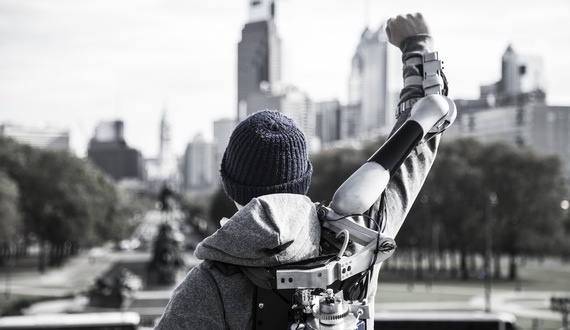By John Knefel
Human bodies are frail machines contrived of snapping sinew and breakable bones. We know this. Hell, we're self-conscious about it. Since Dr. Edward E. Smith sprinkled electric exoskeletons into his sci-fi epics in the late '30s (inspiring Starship Troopers author Robert Heinlein) imagineers have been outfitting humanity with robosuits designed to give us strengths in keeping with our outsized imaginations. Like autonomous weapons and self-driving helicopters, robosuits are now a reality, but Dr. Smith's vision seems increasingly foolish. We're making ourselves stronger, but we're not making ourselves into weapons -- and we may give up the ghost on that effort before the decade ends.
Robotic exoskeletons currently exist in various stages of development and implementation. Most prototypes are designed to help with manual labor or to serve as medical aids for those suffering from mobility-limiting injuries -- people like Mark Pollock, who was rendered paralyzed from the waist down by a spinal injury and can now walk with help from a leg mount produced by the robotics company Esko. These devices augment the abilities of people, allowing them to lift more than they could (even when that's just themselves), but they do not add to those abilities. Iron Man waits in the wings.
The main obstacle preventing engineers from creating a suit capable of acting as a tank/plane/forward operating base is lag time, which is a minor issue for assembly line workers and a big issue for soldiers. The Tactical Assault Light Operator Suit, which the Department of Defense has been working on for two decades, has never been deployed. In October, General Joseph Votel, head of the U.S. Special Operations Command told CNN that "the TALOS program has churned out several prototypes and is on track to deliver a first-generation suit by August 2018." That's hard to believe -- just ask the private sector.
According to a new report from ABI Research, which predicts the commercial exoskeleton market will be worth $2 billion by 2025. "Lower body exoskeletons, employed as rehabilitation tools or quality of life enablers, currently lead the sector," ABI said in a statement on their findings. "However, commercial systems that augment or amplify capabilities will exhibit the strongest growth moving forward. This is especially true for industrial tasks requiring heavy lifting, extended standing, squatting, bending or walking in manufacturing facilities, particularly within construction and agriculture industries."
One of the most impressive exoskeletons on the market comes from Cyberdyne, a Japanese company that happens to share a name with the Terminator prime mover. Their Hybrid Assisted Limb device comes in several models, some for medical use and some for laborers. This summer, Cyberdyne announced a pilot program at Haneda Airport to outfit some workers with lumbar-supporting robo-skeletons to make lifting luggage easier, citing Japan's aging population and low birth rates as two issues they hope to address by easing physical stress from manual labor. Another promising application of exoskeletons comes from Noonee, a company based in Switzerland that makes a product called the "chairless chair." They've had a trial run at an Audi manufacturing plant, and they reportedly have plans for a trial run with BMW. Workers strap braces to their legs that allow them to sit comfortably wherever they're standing, like they're sitting on an invisible seat.
There's a growing market for simpler, unpowered exoskeletons as well. A new knee brace from manufacturer Spring Loaded promises to reduce fatigue and prevent knee injuries in athletes and the elderly.
Whether that lag for these devices can be squeezed so much that users can no longer perceive a delay is unclear, but the devices remain useful even if they slow operators down to some degree. They provide strength. That's it. On a functional basis -- on any basis really -- they share little in common with Swiss Army knives. One function is enough.
And so it was meant to be for the military.
Congress has already allocated $80 million for the TALOS project, but the suit could end up costing "hundreds of millions more to perfect the sophisticated technology," according to the website Defense Tech. Former Republican Senator Tom Coburn included TALOS in his 2014 "Wastebook," an annual report he issued on what he saw as unnecessary government spending. The reason for the inclusion is that the results are somewhat bizarre.
According to The Economist, current versions of the robosuit weigh in around 400 pounds, limit shoulder mobility, and run out of power quickly. The idea of building an engine to run the suits has been met with the Pentagon version of guffaws. Noisy suits don't help ground forces sneak up on their targets, and asking soldiers to wear gas tanks seems unwise.
More importantly, there's no real reason to think special operations troops actually want any of this gear in the first place. In May, The Intercept's Ryan Devereaux attended the Special Operations Forces Industry Conference in Florida, where he was told by one former operator that TALOS had sprawled out of control. "The program started when [Former SOCOM chief Admiral William McRaven] was at SOFIC and said he wanted something that would prevent our first man through the door/door breacher from catching one in the face and taking a long dirt nap," Jack Murphy, a veteran of the U.S. army's 75th Ranger Regiment and 5th Special Forces Group, as well as Editor-in-Chief of SofRep.com, told The Intercept. He explained, "It is a serious concern and something worth trying to find a solution to, but from there it morphed into this Iron Man suit project that no one was actually asking for."
It wouldn't be the first time that Pentagon brass delivered high tech equipment that troops didn't want. In the 1990s, the Pentagon began a program called Land Warrior with the goal of giving soldiers better battlefield awareness with high tech digital maps and radios. After several stops and starts, the gear was finally used in combat in Iraq in 2009. The verdict from the grunts? "It's just a bunch of stuff we don't use, taking the place of useful stuff like guns," Sgt. James Young told Popular Mechanics at the time.
The chairless chair isn't as exciting as TALOS, but it may be a more meaningful implementation of exoskeleton technology. We all want to be able to do more but it turns out that doing better more comfortably ain't nothing. Exoskeletons allow us to conceal our human weakness, but they don't provide us with new strengths -- not now and maybe not ever.
- Automation and Robots Have Only Ever Done One Thing: Make Life Better
- How Oculus Rift Avoided a Launch Day Boondoggle
- The Tech Industry Suddently Wants Customer Feedback But Won't Shut the Hell Up
- Drone School Makes Better Pilots, But That May Not Be the Point
- Is USA's 'Colony' Worth Your Time? Not if You Haven't Seen 'The Expanse'
Photos via Titan Arm

